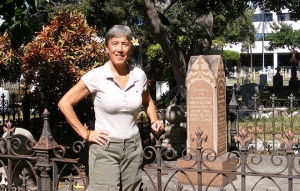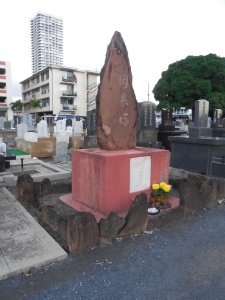Lecture series focuses on preserving cemeteries
By Cheryl Chee Tsutsumi
Honolulu Star Advertiser, Jan 25, 2015
Stones speak to Nanette Napoleon. A tombstone, she points out, can be a revealing snapshot of the deceased’s life, sometimes providing information that’s not documented elsewhere.
“Besides the date and place of birth and death, you may find the person’s occupation, talents, accomplishments, family relationships, military service, cause of death, and religious and group affiliations,” said Napoleon, founder and director of the Hawaii Cemetery Research Project, which underscores the importance of cemeteries not just as repositories for the dead, but as valuable historical, cultural and genealogical resources.
The scope of her work has ranged from giving lectures and leading walking tours to compiling cemetery directories and writing a book (“Oahu Cemetery Burial Ground & Historic Site,” 1998).
While on a 1972 backpacking trip on Maui when she was a college student, Napoleon camped in an old Hawaiian graveyard in remote Kaupo. “That got me thinking about life and death and why we have cemeteries,” she said. “After that I started hanging out in graveyards a lot and found them more and more interesting. Over time this interest became a full-blown passion, prompting me to want to document older sites that were in danger of being destroyed through increasing development.”
Napoleon has been studying Hawaii’s historic cemeteries for more than 30 years and is the state’s leading expert on the subject. Her Thursday talk on “Gravestones and History: Cemeteries as Genealogical Resources” will kick off the 28th annual historic preservation lecture series, themed “Preserving Our Historic Cemeteries.”

Nanette Napoleon stands by the King Street Catholic Cemetery, across the street from Straub Clinic & Hospital. Her talk on “Gravestones and History: Cemeteries as Genealogical Resources” will kick off the 28th annual historic preservation lecture series, themed “Preserving Our Historic Cemeteries.” (Photo courtesy of Dodge Purnell.)
Sponsored by the University of Hawaii at Manoa’s Historic Preservation Program, the Historic Hawai‘i Foundation and the Friends of ‘Iolani Palace, the series has been called Experts at the Palace because it’s usually held at the Old Archives Building on the palace grounds. Due to construction going on there, however, it has been moved to the Hawai‘i State Art Museum (HiSAM) and renamed Experts at HiSAM this year.
Well-known historic preservationist William Murtagh, the first keeper of the National Register of Historic Places, introduced the Experts series in 1988 to help the public delve deeper into Hawaiian history and to raise awareness about preservation concerns. The university had retained him two years earlier to develop a Graduate Certificate Program in Historic Preservation.
“Bill was a wonderful showman and raconteur,” said William Chapman, current director of the Historic Preservation Program and curator of the Experts series. “Many of the earliest speakers were friends and acquaintances from his many years in the field. He even recruited me as a speaker in 1992 when I was visiting for my job interview.”
The distinguished lecturers — including architects, historians, planners and other professionals who are active in historic preservation — have come from throughout Hawaii, the mainland, Europe, Asia and the Pacific to discuss thought-provoking subjects such as “The Heritage of World War II” and “Native Hawaiian Sites and Conservation.”
“Even so, at times in the first years, we were lucky to get an audience of more than five or six,” Chapman said. “Bill would round up people he met at the free morning coffee bar that Longs on Fort Street used to have.”
Over the past decade the room has been filled, and Chapman expects the same for this year’s presentations. “Many of our old cemeteries no longer receive regular maintenance,” he said. “Others are threatened by new development and changes to their surroundings. This is true of Moiliili Cemetery, an urban Japanese cemetery; small graveyards attached to rural chapels; and cemeteries that were part of once-thriving plantation communities. This series is the first step in a greater effort to bring these concerns before the public.”

Scott Pawlowski, chief of cultural and natural resources at the World War II Valor in the Pacific National Monument, will deliver a talk titled “The Arizona Memorial: Maintaining a War Grave” on Feb. 5. (COURTESY HAWAII TOURISM AUTHORITY / KIRK LEE AEDER.)
Kiersten Faulkner, executive director of the Historic Hawai‘i Foundation, agrees the topic is timely. “A great benefit of historic preservation is the ability to gain understanding and empathy for others,” she said. “Cemeteries offer that opportunity in abundance. When I walk through a graveyard, reading the headstones, I’m fascinated by the names, dates and descriptors. I look at a person’s birth or death date and imagine what it would’ve been like to live in that era.”
She notes that inscriptions might hint at love, loss, beliefs, accomplishments or regrets. The designs of the tombstones and the cemeteries themselves convey cultural norms, practices, values and taboos.
“Cemeteries can be simple markers of bygone eras, forgotten to all but a few, or they can be national monuments drawing many visitors who are determined to always remember,” Faulkner said. “By being at the site, imagining the lives of those who are gone, we gain compassion, understanding and greater humanity.”
In just an hour the Experts series’ lecturers bring the past to life, describing how people lived, what they achieved and why it’s important to preserve their legacy. “The best speakers share their knowledge in a way that captures the imagination and serves as a call for greater community involvement and connections,” Faulkner said. “The audience leaves with new appreciation and a renewed sense of responsibility for the conservation of the history of a place and its people.”
Cheryl Chee Tsutsumi is a Honolulu-based freelance writer whose travel features for the Star-Advertiser have won several Society of American Travel Writers awards.
IF YOU GO …
EXPERTS AT HISAM
» Place: Hawaii State Art Museum, No. 1 Capitol Building, 250 S. Hotel St., downtown Honolulu
» Days: Thursdays, beginning this week through March 5
» Time: 12 to 1 p.m.
» Admission: Free
» Phone: 523-2900
» Email: outreach@historichawaii.org
» Notes: The series is best suited for those age 16 and older. First-come, first-served seating is limited to 60 guests.
Related offerings include a free workshop on “Historic Cemetery Preservation and Community Capacity Building” from June 1 to 5, a free public presentation on June 6 about the needs of historic cemeteries and a three-credit field school June 8-12 through the University of Hawaii at Manoa’s Outreach College. Call 956-8570 for details.
THIS WEEK:
THURSDAY, JANUARY 29
“Gravestones and History: Cemeteries as Genealogical Resources”
Nanette Napoleon, founder and director, Hawaii Cemetery Research Project

he Heap of Misfortune — Myles Fukunaga Memorial at Moiliili Japanese Cemetery. “The Moiliili Japanese Cemetery: Preserving a Community Landmark” is the theme of Laura Ruby’s talk Feb. 19. (Photo Courtesy of Laura Ruby.)
STORY BEHIND THE STONE
The words on the stone monument marking the grave of Myles Fukunaga translate as “Heap of Misfortune.” In 1928, Fukunaga kidnapped 10-year-old George Gill Jamieson, the son of the Hawaiian Trust Co. executive who was going to evict the Fukunagas from the house he was renting to them for failure to pay rent. Fukunaga demanded a $10,000 ransom and received $4,000, but he had bludgeoned the boy to death earlier anyway. Fukunaga was hanged at Oahu Prison on Nov. 19, 1929, and buried in Section A of what was then the outskirts of the cemetery.

